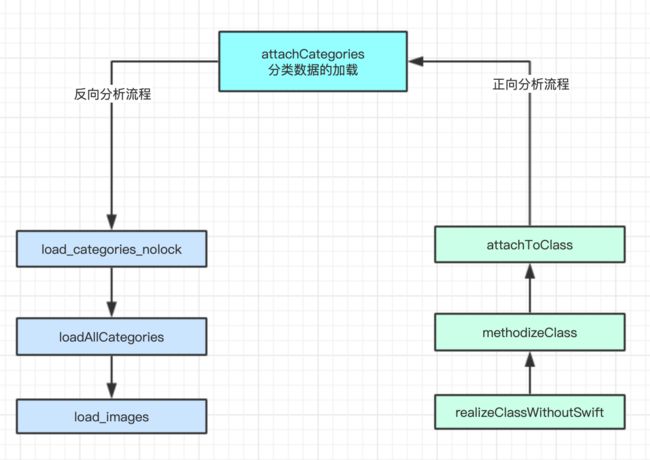iOS 底层探索: 学习大纲 OC篇

前言
在上篇文章中,分析了类的懒加载和非懒加载的情况,在load_images时会调用loadAllCategories()方法加载分类,那么分类的加载是如何实现的呢?接下来我们就分析下分类的加载及其本质。
准备:调试代码下载
一 、 分类的本质
先写一个分类
@interface LGPerson (LG)
@property (nonatomic, copy) NSString *cate_name;
@property (nonatomic, assign) int cate_age;
- (void)cate_instanceMethod1;
- (void)cate_instanceMethod3;
- (void)cate_instanceMethod2;
+ (void)cate_sayClassMethod;
@end
@implementation LGPerson (LG)
- (void)cate_instanceMethod1{
NSLog(@"%s",__func__);
}
- (void)cate_instanceMethod3{
NSLog(@"%s",__func__);
}
- (void)cate_instanceMethod2{
NSLog(@"%s",__func__);
}
+ (void)cate_sayClassMethod{
NSLog(@"%s",__func__);
}
@end
之前我们通过Clang探索过类的本质,同样我们对分类进行Clang 如下:.打开终端,cd到文件目录下,执行clang -rewrite-objc main.m -o main.cpp.利用clang将main.m编译成 main.cpp ,搜索LGPerson。
// @interface LGPerson (LG)
// @property (nonatomic, copy) NSString *cate_name;
// @property (nonatomic, assign) int cate_age;
// - (void)cate_instanceMethod1;
// - (void)cate_instanceMethod3;
// - (void)cate_instanceMethod2;
// + (void)cate_sayClassMethod;
/* @end */
// @implementation LGPerson (LG)
static void _I_LGPerson_LG_cate_instanceMethod1(LGPerson * self, SEL _cmd) {
NSLog((NSString *)&__NSConstantStringImpl__var_folders_hr_l_56yp8j4y11491njzqx6f880000gn_T_main_f129fc_mi_0,__func__);
}
static void _I_LGPerson_LG_cate_instanceMethod3(LGPerson * self, SEL _cmd) {
NSLog((NSString *)&__NSConstantStringImpl__var_folders_hr_l_56yp8j4y11491njzqx6f880000gn_T_main_f129fc_mi_1,__func__);
}
static void _I_LGPerson_LG_cate_instanceMethod2(LGPerson * self, SEL _cmd) {
NSLog((NSString *)&__NSConstantStringImpl__var_folders_hr_l_56yp8j4y11491njzqx6f880000gn_T_main_f129fc_mi_2,__func__);
}
static void _C_LGPerson_LG_cate_sayClassMethod(Class self, SEL _cmd) {
NSLog((NSString *)&__NSConstantStringImpl__var_folders_hr_l_56yp8j4y11491njzqx6f880000gn_T_main_f129fc_mi_3,__func__);
}
// @end
可以看出:分类的属性没有像类的属性一样被编译成结构体NSObject_IMPL ,可参考 iOS 底层探索:isa与类关联的原理 ,继续搜索LGPerson
extern "C" __declspec(dllimport) struct _class_t OBJC_CLASS_$_LGPerson;
static struct _category_t _OBJC_$_CATEGORY_LGPerson_$_LG __attribute__ ((used, section ("__DATA,__objc_const"))) =
{
"LGPerson",
0, // &OBJC_CLASS_$_LGPerson,
(const struct _method_list_t *)&_OBJC_$_CATEGORY_INSTANCE_METHODS_LGPerson_$_LG,
(const struct _method_list_t *)&_OBJC_$_CATEGORY_CLASS_METHODS_LGPerson_$_LG,
0,
(const struct _prop_list_t *)&_OBJC_$_PROP_LIST_LGPerson_$_LG,
};
static void OBJC_CATEGORY_SETUP_$_LGPerson_$_LG(void ) {
_OBJC_$_CATEGORY_LGPerson_$_LG.cls = &OBJC_CLASS_$_LGPerson;
}
可以看到_category_t 这个结构体:
// 分类 : 方法 - attachtoclass
struct _category_t {
const char *name;
struct _class_t *cls;
const struct _method_list_t *instance_methods; // 对象方法
const struct _method_list_t *class_methods;// 类方法
const struct _protocol_list_t *protocols;// 协议
const struct _prop_list_t *properties;// 属性
};
在objc源码中查看:
struct category_t {
const char *name;
classref_t cls;
struct method_list_t *instanceMethods;
struct method_list_t *classMethods;
struct protocol_list_t *protocols;
struct property_list_t *instanceProperties;
// Fields below this point are not always present on disk.
struct property_list_t *_classProperties;
method_list_t *methodsForMeta(bool isMeta) {
if (isMeta) return classMethods;
else return instanceMethods;
}
property_list_t *propertiesForMeta(bool isMeta, struct header_info *hi);
protocol_list_t *protocolsForMeta(bool isMeta) {
if (isMeta) return nullptr;
else return protocols;
}
};
从源码基本可以看出我们平时使用categroy的方式,对象方法,类方法,协议,和属性都可以找到对应的存储方式。并且我们发现分类结构体中是不存在成员变量的,因此分类中是不允许添加成员变量的。
我们再看看分类的方法列表里有没有属性的get、set方法:
static struct /*_method_list_t*/ { 方法列表
unsigned int entsize; // sizeof(struct _objc_method)
unsigned int method_count;
struct _objc_method method_list[3];
} _OBJC_$_CATEGORY_INSTANCE_METHODS_LGPerson_$_LG __attribute__ ((used, section ("__DATA,__objc_const"))) = {
sizeof(_objc_method),
3,
// sel+签名+地址
{{(struct objc_selector *)"cate_instanceMethod1", "v16@0:8", (void *)_I_LGPerson_LG_cate_instanceMethod1},
{(struct objc_selector *)"cate_instanceMethod3", "v16@0:8", (void *)_I_LGPerson_LG_cate_instanceMethod3},
{(struct objc_selector *)"cate_instanceMethod2", "v16@0:8", (void *)_I_LGPerson_LG_cate_instanceMethod2}}
};
static struct /*_method_list_t*/ {
unsigned int entsize; // sizeof(struct _objc_method)
unsigned int method_count;
struct _objc_method method_list[1];
} _OBJC_$_CATEGORY_CLASS_METHODS_LGPerson_$_LG __attribute__ ((used, section ("__DATA,__objc_const"))) = {
sizeof(_objc_method),
1,
{{(struct objc_selector *)"cate_sayClassMethod", "v16@0:8", (void *)_C_LGPerson_LG_cate_sayClassMethod}}
};
extern "C" __declspec(dllimport) struct _class_t OBJC_CLASS_$_LGPerson;
static struct _category_t _OBJC_$_CATEGORY_LGPerson_$_LG __attribute__ ((used, section ("__DATA,__objc_const"))) =
{
"LGPerson",
0, // &OBJC_CLASS_$_LGPerson,
(const struct _method_list_t *)&_OBJC_$_CATEGORY_INSTANCE_METHODS_LGPerson_$_LG,
(const struct _method_list_t *)&_OBJC_$_CATEGORY_CLASS_METHODS_LGPerson_$_LG,
0,
(const struct _prop_list_t *)&_OBJC_$_PROP_LIST_LGPerson_$_LG,
};
static struct /*_prop_list_t*/ {
unsigned int entsize; // sizeof(struct _prop_t)
unsigned int count_of_properties;
struct _prop_t prop_list[2];
} _OBJC_$_PROP_LIST_LGPerson_$_LG __attribute__ ((used, section ("__DATA,__objc_const"))) = {
sizeof(_prop_t),
2,
{{"cate_name","T@\"NSString\",C,N"},
{"cate_age","Ti,N"}}
};
分类中添加的属性并不会帮助我们自动生成成员变量,只会生成get set方法的声明并不实现set get方法。所以我们开发过程中一般不能在分类中使用属性,通过验证可知,分类中的属性编译可以通过,但是在运行时调用,就会出现crash,这个就不验证了。如何让它不crash,我们下一节专门讲解关联属性。
分类总结: 分类的本质 是一个_category_t类型的结构体 ,
- 分类是用于给原有类添加方法的,因为分类的结构体指针中,没有属性列表,只有方法列表 ;
- 分类中的可以写@property, 但不会生成setter/getter方法, 也不会生成实现以及私有的成员变量(编译时会报警告);
有两个属性:name(类的名称) 和 cls(类对象)
- 有两个 method_list_t类型的方法列表,表示分类中实现的实例方法+类方法
- 一个protocol_list_t类型的协议列表,表示分类中实现的协议
- 一个prop_list_t类型的属性列表,表示分类中定义的属性,一般在分类中添加的属性都是通过关联对象来实现
本类属性 和 分类属性的区别:
- 本类属性:在clang编译环节,会自动生成并实现对应的set和get方法
- 分类属性:会存在set、get方法,但是没有实现 (需要runtime设置关联属性)。
分类在编译的时候将分类的信息存在struct _category_t中,那么怎么在程序运行的时候是怎么加载到内存中的呢,接下来看runtime的源码分析分类的加载
二 、 分类的加载
1. 分类的加载时机。
在类的加载上 提到过methodizeClass ,我们再次看看methodizeClass,源码如下:
//方法的序列化
static void methodizeClass(Class cls, Class previously)
{
runtimeLock.assertLocked();
bool isMeta = cls->isMetaClass();
auto rw = cls->data();
auto ro = rw->ro();
auto rwe = rw->ext();
// Methodizing for the first time
if (PrintConnecting) {
_objc_inform("CLASS: methodizing class '%s' %s",
cls->nameForLogging(), isMeta ? "(meta)" : "");
}
// Install methods and properties that the class implements itself.
// 将 ro 里面的方法附加到 rw 里面去
method_list_t *list = ro->baseMethods();
if (list) {
// 准备好方法列表
prepareMethodLists(cls, &list, 1, YES, isBundleClass(cls));
if (rwe) rwe->methods.attachLists(&list, 1);
}
// 将 ro 里面的属性附加到 rw 里面去
property_list_t *proplist = ro->baseProperties;
if (rwe && proplist) {
rwe->properties.attachLists(&proplist, 1);
}
// 将 ro 里面的协议附加到 rw 里面去
protocol_list_t *protolist = ro->baseProtocols;
if (rwe && protolist) {
rwe->protocols.attachLists(&protolist, 1);
}
// 根类获得额外的方法实现,如果它们还没有。这些适用于类别替换之前。
if (cls->isRootMetaclass()) {
// root metaclass
addMethod(cls, @selector(initialize), (IMP)&objc_noop_imp, "", NO);
}
// Attach categories. 附加分类
if (previously) {
if (isMeta) {
objc::unattachedCategories.attachToClass(cls, previously,
ATTACH_METACLASS);
} else {
// When a class relocates, categories with class methods
// may be registered on the class itself rather than on
// the metaclass. Tell attachToClass to look for those.
objc::unattachedCategories.attachToClass(cls, previously,
ATTACH_CLASS_AND_METACLASS);
}
}
objc::unattachedCategories.attachToClass(cls, cls,
isMeta ? ATTACH_METACLASS : ATTACH_CLASS);
......
}
可以发现类的数据和 分类的数据是分开处理的,主要是因为在编译阶段,就已经确定好了方法的归属位置(即实例方法存储在类中,类方法存储在元类中),而分类是后面才加进来的.
-
其中分类需要通过
attatchToClass添加到类,然后才能在外界进行使用,在此过程,我们已经知道了分类加载三步骤的后面两个步骤,分类的加载主要分为3步:分类数据加载时机:根据类和分类是否实现load方法来区分不同的时机
attachCategories准备分类数据attachLists将分类数据添加到主类中
2. 分类与本类的加载与方法调用。
关于多个分类方法的加载 在类的加载上 提到attachLists 。
基本上方法、协议、属性都是通过 attachLists 函数附加到对应的列表上的
void attachLists(List* const * addedLists, uint32_t addedCount) {
if (addedCount == 0) return;
if (hasArray()) {
// many lists -> many lists
//计算数组中旧lists的大小
uint32_t oldCount = array()->count;
//计算新的容量大小 = 旧数据大小+新数据大小
uint32_t newCount = oldCount + addedCount;
//根据新的容量大小,开辟一个数组,类型是 array_t,通过array()获取
setArray((array_t *)realloc(array(), array_t::byteSize(newCount)));
//设置数组大小
array()->count = newCount;
//旧的数据从 addedCount 数组下标开始 存放旧的lists,大小为 旧数据大小 * 单个旧list大小
memmove(array()->lists + addedCount, array()->lists,
oldCount * sizeof(array()->lists[0]));
//新数据从数组 首位置开始存储,存放新的lists,大小为 新数据大小 * 单个list大小
memcpy(
array()->lists, addedLists,
addedCount * sizeof(array()->lists[0]));
}
else if (!list && addedCount == 1) {
// 0 lists -> 1 list
list = addedLists[0];//将list加入mlists的第一个元素,此时的list是一个一维数组
}
else {
// ----------- 分类的处理 ---------------
// 1 list -> many lists 有了一个list,有往里加很多list
//新的list就是分类,来自LRU的算法思维,即最近最少使用
//获取旧的list
List* oldList = list;
uint32_t oldCount = oldList ? 1 : 0;
//计算容量和 = 旧list个数+新lists的个数
uint32_t newCount = oldCount + addedCount;
//开辟一个容量和大小的集合,类型是 array_t,即创建一个数组,放到array中,通过array()获取
setArray((array_t *)malloc(array_t::byteSize(newCount)));
//设置数组的大小
array()->count = newCount;
//判断old是否存在,old肯定是存在的,将旧的list放入到数组的末尾
if (oldList) array()->lists[addedCount] = oldList;
// memcpy(开始位置,放什么,放多大) 是内存平移,从数组起始位置存入新的list
//其中array()->lists 表示首位元素位置
memcpy(array()->lists, addedLists,
addedCount * sizeof(array()->lists[0]));
}
}
我们分析过load_images 类的加载顺序:父类 - > 本类 - > 分类
在
attachLists可知类的方法调用顺序: 通过attachLists的分析可知,类的方法优先存入父类,本类,最后才是分类,多个分类时,会根据编译顺序去存,存在后面方法就会放在方法列表的最前面,所以我们可以得出结论:
- 普通的方法中, 分类同名方法会覆盖主类的方法;
- 多个分类中的同名方法会只执行一个,即后编译的分类里面的方法会覆盖所有前面的同名方法(可以通过调换编译顺序来获得这个结论)。
3. 分类加载的验证
首先创建 一个类 和两个分类 ,
我们知道类的加载会分为懒加载类和非懒加载类;所以在分类加载的验证中我们可以大致分为四种加载情况如下:
通过上面的两个例子,我们可以大致将类 和 分类 是否实现+load的情况分为4种
- 【情况1】
非懒加载类 + 非懒加载分类 - 【情况2】
懒加载类 + 懒加载分类 - 【情况3】
非懒加载类 + 懒加载分类 - 【情况4】
懒加载类 + 非懒加载分类
【 3.1】 全部为非懒加载类的加载的情况下:分类和本类 都实现 load方法
在methodizeClass 中进入attachToClass ,可以发现attachCategories方法,就会进行分类数据的加载
断点调试如下,查看堆栈可以看出分类加载正常的流程的路径为:realizeClassWithoutSwift ->methodizeClass -> attachToClass ->attachCategories
我们 通过堆栈去找到 attachCategories ,发现在attachToClass方法中调用了attachCategories,又 在这个类UnattachedCategories中声明实现了attachToClass 我们断点看看会不会走attachCategories呢?
class UnattachedCategories : public ExplicitInitDenseMap
{
public:
...................
void attachToClass(Class cls, Class previously, int flags)
{
runtimeLock.assertLocked();
ASSERT((flags & ATTACH_CLASS) ||
(flags & ATTACH_METACLASS) ||
(flags & ATTACH_CLASS_AND_METACLASS));
const char *mangledName = cls->mangledName();
const char *LGPersonName = "LGPerson";
if (strcmp(mangledName, LGPersonName) == 0) {
bool kc_isMeta = cls->isMetaClass();
auto kc_rw = cls->data();
auto kc_ro = kc_rw->ro();
printf("%s: 这个是我要研究的 %s \n",__func__,LGPersonName);
// if (!kc_isMeta) {
// printf("%s: 这个是我要研究的 %s \n",__func__,LGPersonName);
// }
}
// 这里 打印 LGPerson 调试看看
auto &map = get();
auto it = map.find(previously);
if (it != map.end()) { // 经过断点调试这里不会走 ,只有在实现多个分类的load方法后才会走这里 可以调试验证
category_list &list = it->second;
if (flags & ATTACH_CLASS_AND_METACLASS) {
int otherFlags = flags & ~ATTACH_CLASS_AND_METACLASS;
attachCategories(cls, list.array(), list.count(), otherFlags | ATTACH_CLASS);
attachCategories(cls->ISA(), list.array(), list.count(), otherFlags | ATTACH_METACLASS);
} else {
attachCategories(cls, list.array(), list.count(), flags);
}
map.erase(it);
}
}
...................
};
断点调试 发现,这里断点并不会走。只有在实现多个分类的load方法后才会走这里 可以调试验证
所以我们全局搜索看看还有谁调用了attachCategories,如下:
static void load_categories_nolock(header_info *hi) {
..........
const char *mangledName = cls->mangledName();
const char *LGPersonName = "LGPerson";
if (strcmp(mangledName, LGPersonName) == 0) {
printf("load_categories_nolock:%s: 这个是我要研究的 %s \n",__func__,LGPersonName);
}
// Process this category.
if (cls->isStubClass()) {
......
} else {
// First, register the category with its target class.
// Then, rebuild the class's method lists (etc) if
// the class is realized.
if (cat->instanceMethods || cat->protocols
|| cat->instanceProperties)
{
if (cls->isRealized()) {
attachCategories(cls, &lc, 1, ATTACH_EXISTING);
} else {
objc::unattachedCategories.addForClass(lc, cls);
}
}
if (cat->classMethods || cat->protocols
|| (hasClassProperties && cat->_classProperties))
{
if (cls->ISA()->isRealized()) {
attachCategories(cls->ISA(), &lc, 1, ATTACH_EXISTING | ATTACH_METACLASS);
} else {
objc::unattachedCategories.addForClass(lc, cls->ISA());
}
}
}
}
};
..........
}
通过打印也可以验证:
经过堆栈就可以发现attachCategories的调用顺序:attachCategories -> load_categories_nolock -> loadAllCategories->load_images
分析流程如图:
【 3.2】 全部为懒加载类的加载的情况下:分类和本类 都不实现 load方法
参考:类的加载中,我们知道懒加载类的加载的情况下 会走lookUpImpOrForward -> realizeClassMaybeSwiftMaybeRelock-> realizeClassWithoutSwift的情况 。
所以我们在realizeClassWithoutSwift下断点调试如下:
通过堆栈信息我们可以验证 懒加载类的加载 是在调用alloc -> objc_alloc方法的时候开始加载的。
不加任何断点,运行程序,获取打印日志
在readClass断点调试如下,然后读取kc_ro,即读取整个data
此时的baseMethodList的count还是16,说明也是从data中读取出来的,所以不需要经过一层缓慢的load_images加载进来,所以说明:懒加载类 与 懒加载分类的数据加载是在消息第一次调用时加载的。
【 3.3.0】 懒加载类 与 非懒加载分类情况下:分类实现 load方法 本类不实现
在readClass断点调试如下:
我们看到 readClass中的cls 中只读取到mach-o中本类的三个方法。
继续运行代码,进入了attachCategories处,在attachLists加入三个断点,继续运行,发现attachLists中0->1加载了HTPerosn本类函数
继续运行代码,发现进入了attachLists中`1->多(有分类的时候进入):
此时addedCount为2,表示当前需要添加的列表有2个元素。并不是只有LGB分类。我们打印 addedLists[0] 和addedLists[1],就找到了LGA和LGB两个分类
- 分析: 为什么本类没有+load方法,只实现分类+load方法,也在app启动前加载出来了呢?
我们查看左边堆栈,load_images调用了prepare_load_methods:
而prepare_load_methods中会检查有没有非懒加载的分类,如果有就执行下面的循环。
循环中在add_category_to_loadable_list加载分类前,会执行realizeClassWithoutSwift先检查本类是否实现。
【 3.3.1】 懒加载类 与 非懒加载分类情况下:分类A实现 load方法 本类和分类B不实现
没有实现分类的加载方法attachCategories,我们去readClass 打印看看。
发现ro中加载好了本类和2个分类的所有数据(15个函数)读取mach-o了所有的方法。
本类无,分类B+load ,分类A无 的结果与这个一样的。
【 3.4】 非懒加载类 与 懒加载分类情况下:本类实现 load方法 分类不实现
同3.3 打印查看 readClass
可以看出:ro函数列表:此时ro读取的是macho中的值,ro中已包含本类和所有函数信息(14个)。函数排序:后加载的分类函数排序在先加载的分类和本类前面。
继续运行,发现没有进入attachCategories内部。
【 3.5】总结:
-
分析方法:
-
- +load方法会使类进入非懒加载,使类提前加载;
-
- readClass中断点分析,抓取当前类LGPerson,通过读取ro内的数据判断编译器加载还是运行时加载类的信息;
-
- addachCategories中抓取当前类LGPerson,进入attchLists,断点分析分类的加载细节(多个分类加载是方法排序分析);
-
- 查看堆栈信息,可观察核心方法的调用链,查看分析调用时机
-
-
本类和分类的+load区别和各种情况分析处理:比较如下:
-
-
非懒加载类 + 非懒加载分类: 启动时,load_images ->...... ->attachCategories中加载所有分类的数据信息;
-
-
-
懒加载类 + 非懒加载分类: 启动时,load_images ->...... ->attachCategories中加载所有分类的数据信息;
-
-
-
懒加载类 + 懒加载分类: 编译器,mach-o中已加载数据;
-
-
-
非懒加载类 + 懒加载分类: 编译器,mach-o中已加载数据;
-
-
-
非懒加载类 + 懒加载分类 + 非懒加载分类: 编译器,mach-o中已加载数据;
-
-
-
汇总如下图:
三、 Category分类与Extension拓展的区别
3.1 Category:类别,分类
- 专门用来给类添加新的方法
- 不能给类添加成员属性,添加了也取不到。
- 分类中用@property定义的变量,只会生成变量的 getter和setter方法,不能生成方法实现和带下划线的成员变量。
3.2 Extension:类拓展
- 可以说成是特殊的分类,已称作匿名分类
- 可以给类添加成员属性、属性、方法,但都是私有的
拓展必须添加在
@interface声明和@implementation实现之间:
Extension拓展与@interface声明是一样的作用,但是Extension拓展中的成员变量、属性、方法都是私有的。- 可以通过
clang,查看编译结果进行验证。Extension类拓展的下划线成员变量、函数等,都直接加入了本类的相关位置,完成相应实现。
①类别中原则上只能增加方法(能添加属性的的原因只是通过runtime(关联对象的方式)解决无setter/getter的问题而已);
②类扩展不仅可以增加方法,还可以增加实例变量(或者属性),只是该实例变量默认是@private类型的(
用范围只能在自身类,而不是子类或其他地方);
③类扩展中声明的方法没被实现,编译器会报警,但是类别中的方法没被实现编译器是不会有任何警告的。这是因为类扩展是在编译阶段被添加到类中,而类别是在运行时添加到类中。
④类扩展不能像类别那样拥有独立的实现部分(@implementation部分),也就是说,类扩展所声明的方法必须依托对应类的实现部分来实现。
⑤定义在 .m 文件中的类扩展方法为私有的,定义在 .h 文件(头文件)中的类扩展方法为公有的。类扩展是在 .m 文件中声明私有方法的非常好的方式。












